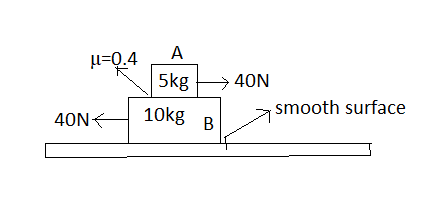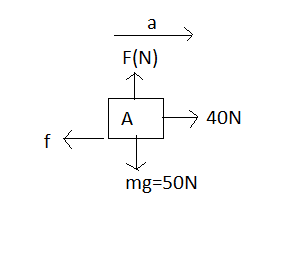
Two blocks (A) and (B) are arranged on a smooth horizontal plane as shown in figure. If two forces of equal magnitude act on the block (A) and block (B). If the ratio of acceleration of block (A) to block (B) is $n:1$ (where n is an integer). Then find$n$. ($g = 10m/{s^2}$)

(A) $1$
(B) $2$
(C) $\dfrac{1}{2}$
(D) $0$
Answer
216k+ views
Hint To make it simpler to understand and solve this problem we first draw the free body diagrams of both the blocks (A) and (B) by isolating the blocks from one another. After drawing the free body diagrams of both the blocks we use friction formula and find the friction force acting on both the blocks. We add all the forces acting on each block and solve for acceleration. We then equate the ratio of acceleration given in the question to the actual ratio of acceleration in both the blocks to find n.
Formula used Friction force $f = \mu {F_N}$
Here,
Friction force is represented by $f$
Coefficient of friction is represented by $\mu $
Normal force is represented by ${F_N}$
Complete Step by step solution
Let us take block (A) first to solve
Free body diagram of block (A) is

The normal force acting on block (A) is
${F_{N - A}} = {m_A}g = 50N$
From the formula of friction force
$f = \mu {F_{N - A}} = 0.4 \times 50 = 20N$
The sum of forces acting on block (A) in horizontal direction,
${m_A}{a_A} = 40 - f$
Acceleration of block (A) is
$ {a_A} = \dfrac{{40 - f}}{{{m_a}}} $
$ {a_A} = \dfrac{{40 - 20}}{5} = 4m/{s^2} $
Here,
Friction force is represented by $f$
Normal force of (A) is represented by ${F_{N - A}}$
Mass of (A) is ${m_A}$
Acceleration of (A) is ${a_A}$
Taking block (B) under consideration
Friction force acting on block (B) will be the same as (A) because the friction force acting is between the surface of block (A) and block (B) with the weight of block (A) as the normal force.
${f_A} = {f_B} = f=20N$
The sum of all the forces acting on block (B) in the horizontal direction,
${m_B}{a_B} = 40 - f$
Acceleration of block (B) is equal to
${a_B} = \dfrac{{40 - f}}{{{m_B}}} $
$ {a_B} = \dfrac{{40 - 20}}{{10}} = 2m/{s^2} $
Here,
Friction force is represented by $f$
Mass of (B) is ${m_B}$
Acceleration of (B) is ${a_B}$
From the question ratio of accelerations is
$\dfrac{{{a_A}}}{{{a_B}}} = n:1 $
$ \dfrac{{{a_A}}}{{{a_B}}} = \dfrac{4}{2} = \dfrac{2}{1} = \dfrac{n}{1} $
Hence $n$ is equal to $2$
Option (B) is the correct answer
Note There is no friction force between the surface of block (B) and the horizontal plane because the horizontal plane is smooth. Hence the friction force is zero between these two surfaces. The sign conventions taken in the above question are positive for right and upward directions, and negative for left and downward directions.
Formula used Friction force $f = \mu {F_N}$
Here,
Friction force is represented by $f$
Coefficient of friction is represented by $\mu $
Normal force is represented by ${F_N}$
Complete Step by step solution
Let us take block (A) first to solve
Free body diagram of block (A) is

The normal force acting on block (A) is
${F_{N - A}} = {m_A}g = 50N$
From the formula of friction force
$f = \mu {F_{N - A}} = 0.4 \times 50 = 20N$
The sum of forces acting on block (A) in horizontal direction,
${m_A}{a_A} = 40 - f$
Acceleration of block (A) is
$ {a_A} = \dfrac{{40 - f}}{{{m_a}}} $
$ {a_A} = \dfrac{{40 - 20}}{5} = 4m/{s^2} $
Here,
Friction force is represented by $f$
Normal force of (A) is represented by ${F_{N - A}}$
Mass of (A) is ${m_A}$
Acceleration of (A) is ${a_A}$
Taking block (B) under consideration
Friction force acting on block (B) will be the same as (A) because the friction force acting is between the surface of block (A) and block (B) with the weight of block (A) as the normal force.
${f_A} = {f_B} = f=20N$
The sum of all the forces acting on block (B) in the horizontal direction,
${m_B}{a_B} = 40 - f$
Acceleration of block (B) is equal to
${a_B} = \dfrac{{40 - f}}{{{m_B}}} $
$ {a_B} = \dfrac{{40 - 20}}{{10}} = 2m/{s^2} $
Here,
Friction force is represented by $f$
Mass of (B) is ${m_B}$
Acceleration of (B) is ${a_B}$
From the question ratio of accelerations is
$\dfrac{{{a_A}}}{{{a_B}}} = n:1 $
$ \dfrac{{{a_A}}}{{{a_B}}} = \dfrac{4}{2} = \dfrac{2}{1} = \dfrac{n}{1} $
Hence $n$ is equal to $2$
Option (B) is the correct answer
Note There is no friction force between the surface of block (B) and the horizontal plane because the horizontal plane is smooth. Hence the friction force is zero between these two surfaces. The sign conventions taken in the above question are positive for right and upward directions, and negative for left and downward directions.
Recently Updated Pages
JEE Atomic Structure and Chemical Bonding important Concepts and Tips

JEE Amino Acids and Peptides Important Concepts and Tips for Exam Preparation

Electricity and Magnetism Explained: Key Concepts & Applications

Chemical Properties of Hydrogen - Important Concepts for JEE Exam Preparation

JEE Energetics Important Concepts and Tips for Exam Preparation

JEE Isolation, Preparation and Properties of Non-metals Important Concepts and Tips for Exam Preparation

Trending doubts
JEE Main Correction Window 2026 Session 1 Dates Announced - Edit Form Details, Dates and Link

Atomic Structure: Definition, Models, and Examples

Ideal and Non-Ideal Solutions Explained for Class 12 Chemistry

Degree of Dissociation: Meaning, Formula, Calculation & Uses

Understanding Electromagnetic Waves and Their Importance

Geostationary and Geosynchronous Satellites Explained

Other Pages
Inertial and Non-Inertial Frame of Reference Explained

Clemmensen and Wolff Kishner Reductions Explained for JEE & NEET

JEE Main 2023 January 29th Shift 2 Physics Question Paper with Answer Keys and Solutions

Current Loop as a Magnetic Dipole: Concept, Derivation, and Examples

Two identical balls are projected one vertically up class 11 physics JEE_MAIN

NCERT Solutions For Class 11 Physics Chapter 13 Oscillations - 2025-26




